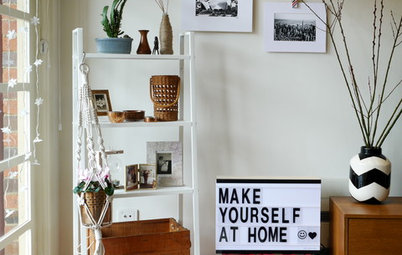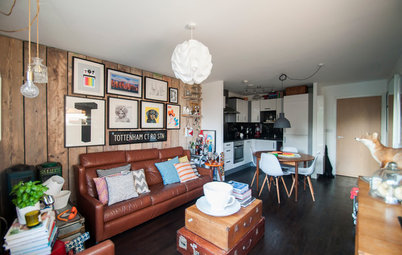Decorating
The Dos and Don'ts of Bringing Nautical Style Into the 21st Century
Nautical style has evolved well beyond anchors, rope and shades of red, white and blue. Here's how to nod to nautical in a contemporary way
When most people think of nautical, beach-style interiors, visions of relaxing and restful spaces come to mind, and rooms that replicate that precious feeling you have when you have just visited the beach or been away on a coastal holiday. The real key, however, is to introduce thoughtful little touches of seaside nostalgia and nods to the coast, without interrupting the effortless and calming vibe. It’s not all about anchors and uninspiring nautical colour schemes.
Follow these few simple dos and don’ts on how to introduce contemporary and fresh nods to nautical, without having to completely redesign your space.
Follow these few simple dos and don’ts on how to introduce contemporary and fresh nods to nautical, without having to completely redesign your space.
Notice how this interior uses a mix of neutral tones and textures to give the room depth and interest. The inclusion of greenery and interesting little natural accessories evoke a calming, effortless feel.
Accents
DO: Stick with a neutral base using natural colours and blues with fresh greenery. Be mindful of the mood you would like to set. A coastal-inspired interior should appear casually chic so replicate this through the colour scheme and avoid anything busy or over the top when it comes to colour.
DON’T: Add too many colours – be selective. Nautical, beach-inspired interiors stick to only a few colour ways, usually neutrals, blues and small amounts of red. Nautical-themed rooms are popular for boys and children’s spaces, with a bolder use of red, white and blue.
BONUS TIP: For a more contemporary take, adjust your colour proportions to 60 per cent neutral with 30 per cent blue and 10 per cent red. The neutral would take up the wall colour, furniture and flooring, with blue and red being introduced through soft furnishings and wall art – it’s all about proportions.
DO: Stick with a neutral base using natural colours and blues with fresh greenery. Be mindful of the mood you would like to set. A coastal-inspired interior should appear casually chic so replicate this through the colour scheme and avoid anything busy or over the top when it comes to colour.
DON’T: Add too many colours – be selective. Nautical, beach-inspired interiors stick to only a few colour ways, usually neutrals, blues and small amounts of red. Nautical-themed rooms are popular for boys and children’s spaces, with a bolder use of red, white and blue.
BONUS TIP: For a more contemporary take, adjust your colour proportions to 60 per cent neutral with 30 per cent blue and 10 per cent red. The neutral would take up the wall colour, furniture and flooring, with blue and red being introduced through soft furnishings and wall art – it’s all about proportions.
Sailor’s stripes
DO: Think outside the box and try using stripes in unexpected ways to get that nautical vibe going. Stripes provide a traditional nod to the nautical theme, yet make a bold and contemporary statement, inject personality and add a focal point to any room.
DON’T: Go overboard – excuse the pun, but use some restraint when deciding where to use stripes; it is all in the execution and you need to consider the space. Vertical stripes are a more traditional use and can elongate a room if you want to make a space feel as if it has higher ceilings, or horizontal stripes can widen the room and are considered a more contemporary approach, creating repetition and pattern.
BONUS TIP: You can get this look using paint or wallpaper. Experiment with the thickness of the stripes as this will impact the proportions of the room, as well as the energy.
DO: Think outside the box and try using stripes in unexpected ways to get that nautical vibe going. Stripes provide a traditional nod to the nautical theme, yet make a bold and contemporary statement, inject personality and add a focal point to any room.
DON’T: Go overboard – excuse the pun, but use some restraint when deciding where to use stripes; it is all in the execution and you need to consider the space. Vertical stripes are a more traditional use and can elongate a room if you want to make a space feel as if it has higher ceilings, or horizontal stripes can widen the room and are considered a more contemporary approach, creating repetition and pattern.
BONUS TIP: You can get this look using paint or wallpaper. Experiment with the thickness of the stripes as this will impact the proportions of the room, as well as the energy.
Stripes don’t have to be bold or overpowering either. Here, an icy cool blue-and-white striped wall has been used to evoke a contemporary yet calming interior with thoughtful nods to the coast through lighting and accessories.
Materials
DO: Keep the textures natural. Choose jute, sisal, rope, rattan and wicker and add these through your furniture, rugs and homewares choices. Various materials add interest here – there are different textures at play to add contrast and something to touch and feel. Wishbone-style chairs give a contemporary edge to a coastal theme, especially the choice of chair colour and materials – white with a natural-fibre base.
DON’T: Go shiny or glossy.
Nautical style is weathered, textured and collected, so stay away from anything that appears ultra-glossy, shiny or reflective, as this gives an ultra-modern appeal and won’t give you the relaxed, laid-back feel you are after.
DO: Keep the textures natural. Choose jute, sisal, rope, rattan and wicker and add these through your furniture, rugs and homewares choices. Various materials add interest here – there are different textures at play to add contrast and something to touch and feel. Wishbone-style chairs give a contemporary edge to a coastal theme, especially the choice of chair colour and materials – white with a natural-fibre base.
DON’T: Go shiny or glossy.
Nautical style is weathered, textured and collected, so stay away from anything that appears ultra-glossy, shiny or reflective, as this gives an ultra-modern appeal and won’t give you the relaxed, laid-back feel you are after.
The headboard is the focal point in this bedroom; it has created a weathered, beachy aesthetic in a refined and contemporary way. The palette is relatively neutral but used a variety of tones and the blue throw rug is like a soft refreshing wave washing over the bed.
Light and breezy
DO: Go for a light, bright and open feel. If you have the luxury of an outdoor area, make it an extension of your home by choosing outdoor furniture in the coastal aesthetic – rattan and wicker works best.
DON’T: Close off your home with heavy drapes or curtains. Instead, choose sheer and breezy fabrics to dress your windows so you allow all that light in!
BONUS TIP: Got an old timber outdoor setting? Try sanding it back and painting it white, then adding nautical-style cushions and accessories in neutrals and blues.
More: How to Take Your Balcony From Bland to Grand
DO: Go for a light, bright and open feel. If you have the luxury of an outdoor area, make it an extension of your home by choosing outdoor furniture in the coastal aesthetic – rattan and wicker works best.
DON’T: Close off your home with heavy drapes or curtains. Instead, choose sheer and breezy fabrics to dress your windows so you allow all that light in!
BONUS TIP: Got an old timber outdoor setting? Try sanding it back and painting it white, then adding nautical-style cushions and accessories in neutrals and blues.
More: How to Take Your Balcony From Bland to Grand
Openness and natural light is what you are after for the nautical beach-style interior. Try to make the most of the outdoors if you have the luxury of a patio, balcony or courtyard and let the breeze flow!
Accessories
DO: Imagine the beach when choosing your accessories for this interior style. Opt for textured, weathered and rustic finds in muted natural colours. The accessories you choose to display should remind you of beachside holidays and can be little trinkets and collections you have found. Driftwood, coral, seashells, textured wood and dried grasses and flowers, for example.
DON’T: To avoid an overly styled and store-bought look, aim to combine found items with purchased items. Go easy on the stereotypical ‘beachy’ themed accessories. Instead, pay attention to the overall vibe you are trying to portray and remember to vary the textures, sizes, shapes and tones.
TELL US
What does modern nautical style mean to you? Share your thoughts in the comments section.
MORE
So Your Style Is: Beach
10 Rules of Australian Beach Style
USA Houzz: Be Inspired by Beachy Elegance in the Hamptons
Not Sure What to Pair With a Striped Sofa?
DO: Imagine the beach when choosing your accessories for this interior style. Opt for textured, weathered and rustic finds in muted natural colours. The accessories you choose to display should remind you of beachside holidays and can be little trinkets and collections you have found. Driftwood, coral, seashells, textured wood and dried grasses and flowers, for example.
DON’T: To avoid an overly styled and store-bought look, aim to combine found items with purchased items. Go easy on the stereotypical ‘beachy’ themed accessories. Instead, pay attention to the overall vibe you are trying to portray and remember to vary the textures, sizes, shapes and tones.
TELL US
What does modern nautical style mean to you? Share your thoughts in the comments section.
MORE
So Your Style Is: Beach
10 Rules of Australian Beach Style
USA Houzz: Be Inspired by Beachy Elegance in the Hamptons
Not Sure What to Pair With a Striped Sofa?



















DO: Keep it light and bright. Nautical and beach-style interiors should evoke a relaxed, casual and effortless feel, so keep the interiors pale, breezy and mix up your neutrals. Opt for a blend of crisp whites with warmer whites, beiges and sandy tones to get depth and interest within a neutral interior – and remember to layer up your textures!
DON’T: Introduce dark and moody tones. Keep the darker paints and ultra-mod, high-gloss homewares in the cupboard for this interior style. Nautical interiors should be fresh and play on natural light and the feeling of openness – you want the space to feel light and bright, not cosy or moody. Blue and navy tones are the exception.